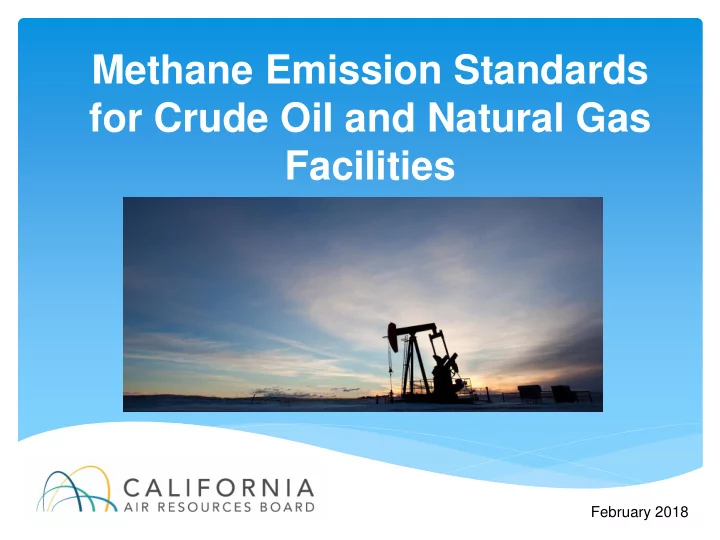

Methane Emission Standards for Crude Oil and Natural Gas Facilities February 2018
Overview Background Regulation Requirements and Impacts Implementation 2
Background 3
Policy Drivers Climate Change Scoping Plans identify oil & gas sector as large source of Greenhouse Gas (GHG) emissions. Combustion CO2 covered by Cap and Trade Methane covered by this regulation Short-Lived Climate Pollutant (SLCP) Strategy includes a target of 40-45 percent reduction in methane from oil & gas sector as a whole by 2025. Recent, separate legislation addressing well stimulation and underground storage monitoring. 4
California 2013 Methane Emission Sources Oil & Gas Extraction and Storage Landfills 4% 20% Pipelines 9% Industrial & Agriculture Miscellaneous 58% 5% Wastewater 4% 5
California’s Oil & Gas Operations Dry Natural Gas Third largest oil producer, (~1,700 wells) 15 th largest natural gas producer Most natural gas is associated gas in California Oil fields generally old, with enhanced recovery: Thermal, well stimulation Around 300 producers Crude Oil & impacted by regulation Associated Gas (~68,000 wells) 6
ARB and District Responsibilities ARB primarily responsible for mobile sources, fuels, and GHGs. 35 Local Air Districts responsible for stationary sources. ARB’s responsibility can include stationary sources when Toxic Air Contaminants (TACs) or GHGs involved. 7
Other Regulations Districts regulating oil & gas for Volatile Organic Compounds (VOCs) for decades; exempt methane. ARB’s regulation covers leaking equipment not already covered by air district rules. Public Utilities Commission developed best practices to be consistent with ARB’s regulation. ARB regulation covers new and existing sources, and is generally more stringent and broader than federal requirements. 8
Regulation Requirements and Impacts 9
Applicability The regulation addresses fugitive and vented emissions of methane from both new and existing oil and gas facilities. The covered facilities include: • Oil and Gas Production, Processing, and Storage • Gathering and Boosting Stations • Natural Gas Underground Storage • Compressor Stations 10
Regulation Standards Separator and Tank Systems Applies to systems at all regulated facilities. Requires flash testing to determine annual methane emissions. Requires systems with annual emissions above 10 metric tons (MT) methane to install vapor collection. Exemptions for low throughput systems and small gauge tanks. 11
Regulation Standards Circulation Tanks Tanks used as part of a well stimulation treatment. Operators institute a Best Practices Management Plan, followed by a control equipment technical assessment. If technical assessment proves out, tanks controlled for emissions by January 1, 2020. 12
Regulation Standards Leak Detection & Repair (LDAR) Requires daily inspections and quarterly testing to check components for leaks. Builds on current requirements by many districts to control VOCs. Regulation will extend testing to methane at natural gas facilities. Optical Gas Imaging for screening, but US EPA Method 21 for enforcement. 13
Regulation Standards Underground Gas Storage Monitoring program designed for the early detection of leaks: • Ambient air monitoring • Daily or continuous monitoring at injection/withdrawal wells. • Incorporates recent legislative requirements. Operators submit monitoring plans to ARB for approval. 14
Regulation Standards Natural Gas Compressors Emission standards for reciprocating compressor rod packings and centrifugal compressor wet seals. Requires either (1) replacement of high-emitting rod packing or wet seal, or (2) collection of leaking gas. All compressors subject to LDAR. 15
Regulation Standards Pneumatic Devices & Pumps Continuous to no-bleed: • Air or electricity to operate; or, • Controlled with a vapor collection system Other Measuring and Reporting Requirements 16
GHG Emission Reductions & Costs Overall estimated annualized cost, with natural gas savings, of $27,300,000 Estimated continuing reductions of more than 1.4 million MT of CO2 equivalent per year, using a 20 year Global Warming Potential for methane. Estimated overall cost-effectiveness of $19 per MT of CO2 equivalent reduced. 17
Emission Reduction Co-Benefits Over 3,600 tons per year (TPY) of VOC reductions statewide. Over 100 TPY of reductions statewide of Toxic Air Contaminants, such as Benzene, Toluene, Ethyl- Benzene, and Xylenes. Neutral statewide Oxides of Nitrogen (NOx) impact. 18
Implementation 19
Implementation Dates January 1, 2018: • Flash testing • LDAR inspections • Natural gas storage monitoring plans • Registration and permitting January 1, 2019: • Vapor collection on separator & tank systems • Pneumatic devices and compressor seal change-outs • Circulation tank technology assessment January 1, 2020: • Circulation tank vapor collection, pending technology assessment 20
Implementation Regulation allows both ARB and the districts to implement; district implementation is preferred. ARB and districts developed a model Memorandum of Agreement (MOA) to specify roles and responsibilities. • Coordinate enforcement, and support information and data sharing. • MOAs may be tailored for specific district needs. 21
Implementation About half of the MOAs have been signed; rest are in progress. For most districts, CARB handling one-time facility and equipment reporting; districts handling “on the ground” enforcement . Will review data being reported under program and monitor program implementation. Will periodically update Board on status and propose adjustments as necessary. 22
Questions? Jim Nyarady, PE jim.nyarady@arb.ca.gov 916-322-8273 https://www.arb.ca.gov/cc/oil-gas/oil-gas.htm 23
Recommend
More recommend